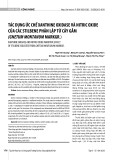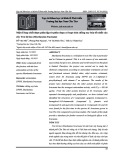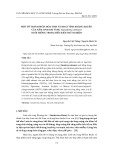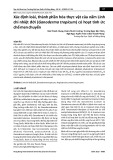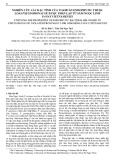
31
https://doi.org/10.52111/qnjs.2023.17103
Tạp chí Khoa học Trường Đại học Quy Nhơn, 2023, 17(1), 31-37
Thành phần hóa học từ cành cây Máu chó đá
(Knema saxatilis)
Lê Nguyễn Thành1,*, Trần Hữu Giáp1, Hà Thị Thoa1, Vũ Thị Huế1, Nguyễn Hoàng Nam1,
Nguyễn Quốc Vượng1, Nguyễn Thành Công2, Diệp Thị Lan Phương3,*
1Viện Hóa sinh biển, Viện Hàn lâm Khoa học và Công nghệ Việt Nam, Việt Nam
2Khoa Dược, Trường Đại học Đại Nam, Việt Nam
3Khoa Khoa học Tự nhiên, Trường Đại học Quy Nhơn, Việt Nam
Ngày nhận bài: 27/09/2022; Ngày nhận đăng: 13/12/2022; Ngày xuất bản: 28/02/2023
TÓM TẮT
NghiêncứuthànhphầnhóahọccủacànhcâyMáuchóđáKnema saxatilis đãphânlậpđược6hợpchất.
Cấu trúc hóa học của chúng được xác định dựa trên các phổ MS và NMR, đó là 8-hydroxy eriodictyol (1),
(2S)-7-hydroxy-3′,4′-methylenedioxideflavan(2), sitostenone (3), protocatechuic acid (4),4-hydroxybenzoicacid
(5)vàvanillin (6).Trong6hợpchấtphânlậpcó1 và 3-6làcáchợpchấtlầnđầutiênđượcbáocáochochiKnema.
Từ khóa: Knema saxatilis, flavonoid, phenolic acid, flavan, sterol.
*Tác giả liên hệ chính.
Email: lethanh@imbc.vast.vn, diepthilanphuong@qnu.edu.vn
TRƯỜNG ĐẠI HỌC QUY NHƠN
KHOA HỌC
TẠP CHÍ

32
QUY NHON UNIVERSITY
SCIENCE
JOURNAL OF
Quy Nhon University Journal of Science, 2023, 17(1), 31-37
https://doi.org/10.52111/qnjs.2023.17103
Chemical constituents of stems of Knema saxatilis
Le Nguyen Thanh1,*, Tran Huu Giap1, Ha Thi Thoa1, Vu Thi Hue1,
Nguyen Hoang Nam1, Nguyen Quoc Vuong1, Nguyen Thanh Cong2,
Diep Thi Lan Phuong3,*
1Institute of Marine Biochemistry, Vietnam Academy of Science and Technology, Vietnam
2Faculty of Pharmacy, Dai Nam University, Vietnam
3Faculty of Natural Sciences, Quy Nhon University, Vietnam
Received: 27/09/2022; Accepted: 13/12/2022; Published: 28/02/2023
ABSTRACT
Phytochemical study of Knema saxatilis stems led to the isolation of six known compounds. Their chemical
structures were determined as 8-hydroxy eriodictyol (1), (2S)-7-hydroxy-3′,4′-methylenedioxideflavan (2),
sitostenone (3), protocatechuic acid (4),4-hydroxybenzoicacid (5)andvanillin (6) using NMR and MS spectral
data. Among the isolated compounds, compounds 1 and 3-6werereportedforthefirsttimefromthegenusKnema.
Keywords: Knema saxatilis, flavonoid, phenolic acid, flavan, sterol.
*Corresponding authors.
Email: lethanh@imbc.vast.vn, diepthilanphuong@qnu.edu.vn
1. INTRODUCTION
Knema saxatilis, locally called “Mau cho da”,
isanativeplantinVietnamwithredresinsin
thebark,referredtotheword“maucho”inits
local name. Knema species have been used in
the traditional medicine for the treatment of skin
diseases, sore throat pains and cancers.1Previous
chemical studies of Knema species led to the
isolationofphenollipidderivatives,flavonoids,
lignans, terpenes and sterols.2-7 Plants in this
genus exhibited possessed a wide range of
pharmacological effects such as anticancer,
antidiabetic,antibacterialandanti-inflammatory
activities.2-7
In the continuation of our study on
Knema plants in Vietnam,8-12 we reported
herein the isolation and elucidation of six
compounds including 8-hydroxy eridictyol (1),
(2S)-7-hydroxy-3′,4′-methylene- dioxideflavan
(2), sitostenone (3), protocatechuic acid (4),
4-hydroxybenzoic acid (5), and vanillin (6).
Theirstructuresweredeterminedbycomparison
of their NMR and MS spectral data with the
reported literature.
2. MATERIALS AND METHODS
2.1. Plant materials
The plant stems were collected in Quangtri
province, Vietnam in 2015. The plant was
identified as Knema saxatilis de Wilde by Dr.
NguyenQuocBinh,VietnamMuseumofNature.
Avoucherspecimen(VN-1672)waspreserved
attheInstituteofMarineBiochemistry,VAST.
2.2. General experimental procedures
The 1H-NMR (500 MHz) and 13C-NMR (125
MHz)spectrawereobtainedbyaBrukerAM500

33
QUY NHON UNIVERSITY
SCIENCE
JOURNAL OF
Quy Nhon University Journal of Science, 2023, 17(1), 31-37
https://doi.org/10.52111/qnjs.2023.17103
FT-NMRspectrometerusingTMSasaninternal
standardandchemicalshiftareexpressedinppm.
TheESI-MSspectrawererecordedonanAgilent
1260LC/MSsystem.Columnchromatography
(CC)wascarriedoutonsilicagel(Merck,230-
400 mesh) or Sephadex® LH-20. Thin layer
chromatography used precoated silica gel plates
(Merck60F254). Compounds were visualized by
UVlamp(254nm)orsprayingwith10%sulfuric
acid and heating.
2.3. Extraction and isolation
The dried, powdered plant materials of K.
saxatilis (1.12 kg) were consecutively macerated
(3L x 3 times, 1 day/time) with hexane, ethyl
acetate and MeOH at room temperature. The
organicextractswerecombinedandremovedin
vacuotoaffordhexane(5g),ethylacetate(14.2g)
and MeOH residue (53 g), respectively.
ThehexaneandEtOAcresidue(19g)was
subjected to a silica gel CC (4 cm size) and eluted
usinggradientsolventshexane/EtOAc(100:1to
0:1,v/v)toafford8fractions(F1-F8).Fraction
F2(370mg)wasfractionatedonsilicagelCC
(2 cm size), eluted with hexane/EtOAc (19:1,
v/v)toaffordthreesub-fractionF2.1-F2.3.Sub-
fractionF2.1(80mg)waspurifiedbysilicagel
CC(1.5cmsize),elutedwithhexane/CH2Cl2 to
give 3(7mg).FractionF5(830mg)wasseparated
on silica gel CC (2.5 cm size) using hexane/
EtOAc(19:1,v/v)aseluenttogivefivefractions
F5.1-F.5.5.Fraction F5.1(70mg)waspurified
on silica gel CC (1.5 cm size) and eluted with
CH2Cl2/MeOH(99/1,v/v)toyield2 (3.5 mg).
Fraction F5.2 (150 mg) was separated on
silica gel CC (2 cm size), eluted with hexane/
EtOAc (19:1, v/v) to afford four sub-fractions
F5.2.1-F5.2.4.Sub-fractionF5.2.3(30mg)was
furtherpurifiedonsilicagelCC(1cmsize)and
eluted with CH2Cl2/MeOH (99/1, v/v) to yield
6(4mg).FractionF7(260mg)wasseparated
on Sephadex® LH-20 CC (2 cm size) using
CH2Cl2/MeOH(2/8,v/v)aseluenttogivefour
fraction F7.1-F7.4. Fraction F7.4 (15 mg) was
purifiedonsilicagelCC(1cmsize)andeluted
with CH2Cl2/MeOH(99/1,v/v)toyield5 (4 mg).
The MeOH residue (53 g) was fractionated
on silica gel CC (4 cm size) and eluted using
gradient solvents CH2Cl2/MeOH (100/1to0/1,
v/v)toafford12fractionsM1-M12.FractionM6
(1.7g)waspurifiedonSephadex®LH-20 (2.5
cm size) eluted with CH2Cl2/MeOH (1/9, v/v)
toaffordfoursub-fractionM6.1-M6.4.Fraction
M6.2(110mg)waspurifiedonSephadex®LH-
20CC(1.5cmsize)usingCH2Cl2/MeOH(2/8,
v/v)togive4(13mg).FractionM6.3(70mg)
was separated on silica gel CC (1.5 cm size),
eluted with CH2Cl2/acetone(8/2,v/v)toyield1
(5 mg).
8-Hydroxy eriodictyol (1) white solid,
[α]D
25 –50° (c 0.3, MeOH); ESI-MS: m/z 305
[M+H]+. 1H-NMR(500MHz,CDCl3+ CD3OD)
δ (ppm): 6.94 (1H, d, J = 2.0 Hz, H-2'), 6.85
(1H, d, J=8.0Hz,H-5'),6.81(1H,dd,J=2.0Hz,
8.0Hz,H-6'),5.97(1H,s,H-6),5.27(1H,dd,
J=12.5Hz,3.0Hz,H-2),3.06(1H,dd,J=17.0Hz,
12.5Hz,H-3a),2.73(1H,dd,J=17.0Hz,3.0Hz,
H-3b). 13C-NMR (125 MHz, CDCl3+ CD3OD)
δ (ppm):196.2(C-4),166.9(C-7),163.7(C-9),
163.3 (C-5), 145.3 (C-4′), 144.9 (C-3′), 130.4
(C-1′), 126.0 (C-8), 118.5 (C-6′), 115.3 (C-5′),
113.5(C-2′),102.5(C-10),96.6(C-6),79.1(C-2),
43.1(C-3).
(2S)-7-hydroxy-3′,4′-
methylenedioxideflavan (2)whitesolid,[α]25
D:
-14.2(c0.4;CHCl3). ESI-MS:m/z271[M+H]+.
1H-NMR(500MHz,CDCl3),δ(ppm):6.92(1H,d,
J=8.0Hz,H-5),6.91(1H,s,H-2′),6.87(1H,d,
J=8.5Hz,H-6′),6.81(1H,d,J=8.5Hz,H-5′),
6.39(1H,d,8.0HzH-6),6.38(1H,s,H-8),5.95
(1H, s, H-7′), 4.95 (1H, dd, J = 10 Hz, H-2),
2.88and2.70(2H,m,H-4),2.13and2.03(2H,m,
H-3).13C-NMR (125 MHz, CDCl3) δ (ppm):
155.8(C-9),154.9(C-7),147.7(C-3′),147.2(C-4′),
135.6 (C-1′), 130.1 (C-5), 119.6 (C-6′), 114.1

34
QUY NHON UNIVERSITY
SCIENCE
JOURNAL OF
Quy Nhon University Journal of Science, 2023, 17(1), 31-37
https://doi.org/10.52111/qnjs.2023.17103
(C-10),108.2(C-5′),108.0(C-6),106.7(C-2′),
103.5(C-8),101.1(C-7′),77.8(C-2),30.0(C-4),
24.4(C-3).
Sitostenone (3) white solid. ESI-MS
m/z413 [M+H]+. 1H-NMR (500MHz, CDCl3),
δ(ppm):5.72(1H,s,H-40),1.17(3H,s,H-19),
0.91 (3H, d, J = 6.5 Hz, H-21), 0.84 (3H, t,
J =7.5Hz,H-29),0.83(3H,d,J =7.0Hz,H-27),
0.81 (3H, d, J = 7.0 Hz, H-26), 0.70 (3H, s,
H-18). 13C-NMR (125 MHz, CDCl3),δ(ppm):
199.6(C-3),171.7(C-5),123.7(C-4),56.0(C-14),
55.9(C-17),53.8(C-9),45.9(C-24),42.4(C-13),
39.6(C-12),38.6(C-10),36.1(C-20),35.7(C-1),
35.6(C-8),34.0(C-2),33.9(C-22),33.0(C-6),
32.1(C-7),29.2(C-25),28.2(C-16),26.1(C-23),
24.2(C-15),23.1(C-28),21.0(C-11),19.8(C-26),
19.0(C-27),18.7(C-21),17.4(C-19),12.0(C-29),
11.9(C-18).
Protocatechuic acid (4): brown solid.
ESI-MS m/z 155 [M+H]+. 1H-NMR (500MHz,
CDCl3+ CD3OD),δ(ppm):7.41(1H,d,J = 1.5
Hz,H-2),7.41(1H,dd,J = 8.5 Hz, J =1.5 Hz,
H-6),6.76(1H,d,J =8.5Hz,H-5).13C-NMR
(125 MHz, CDCl3+ CD3OD), δ (ppm): 169.4
(COOH);149.6(C-4);144.0(C-3),123.2(C-1),
121.6(C-6);116.4(C-5);114.5(C-2).
4-Hydroxybenzoic acid (5): brown solid.
ESI-MS m/z 139 [M+H]+. 1H-NMR (500MHz,
CD3OD), δ (ppm): 7.85 (2H, d, J = 8.5 Hz,
H-2,H-6),6.76(2H,d,J =8.5Hz,H-3,H-5).
13C-NMR(125MHz,CD3OD),δ(ppm):169.9
(COOH),163.1(C-4), 133.0(C-2,C-6),122.6
(C-1),116.0(C-3,C-5).
Vanillin (6): pale yellow solid. ESI-MS
m/z153[M+H]+. 1H-NMR(500MHz,CDCl3)
δ(ppm): 9.83(1H,s,CHO),7.43(2H,m,H-2,
H-6),7.04(1H,d,J=8.5Hz,H-5),6.26(1H,
OH), 3.97 (3H, s, OMe). 13C-NMR (125 MHz,
CDCl3), δ (ppm): 190.8 (CHO), 151.8 (C-3),
147.2(C-4),129.8(C-1),127.4(C-6),114.4(C-
5),108.8(C-2),56.0(OMe).
3. RESULTS AND DISCUSSION
Compound 1 was isolated as a white solid. The
ESI-MSspectrumrevealedapseudo-molecular
ion peak at m/z 305 [M+H]+, suggested the
molecular formula of 1 is C15H12O7 (M= 304).
The 1H NMR spectrum showed signals of a
flavanonestructurewiththreeprotonsofanABX
system at δH 6.94 (1H, d, J=2.0Hz,H-2'),6.85
(1H, d, J=8.0Hz,H-5'),6.81(1H,dd,J=2.0Hz,
8.0Hz,H-6'),anaromaticsingletatδH 5.97 (1H,
s, H-6). In addition, signals of benzopyranone
moiety were observed with a signal at δH 5.27
(1H, dd, J=12.5Hz,3.0Hz,H-2)and2protons
at δH 3.06(1H,dd,J=17.0Hz,12.5Hz,H-3a)
and 2.73 (1H, dd, J=17.0Hz,3.0Hz,H-3b).
The 13C-NMR showed 15 carbon signals of a
flavanone including a carbonyl carbon at δC
196.2(C-4),12aromaticcarbonsrangingfrom
166.9to96.6ppm,anoxymethinecarbonatδC
79.1(C-2)andamethylenegroupatδC43.1(C-3).
IntheHMBCspectrum,thecorrelationsofH-6
(δH 5.97)toC-7(δC166.9),C-5(δC 163.3) and
C-10 (δC 102.5) were observed, suggested a
hydroxylgroupwassubstitutedatC-8(Fig.2).
Based on above spectral evidences, compound
1 was identified as 8-hydroxy eriodictyol. The
analyticalNMRdataof1 are in accordance with
those published.13
Compound 2 was obtained as a white solid.
TheESI-MSshowedaprotonatedmolecularion
peak m/z271[M+H]+, corresponding to C16H14O4
(M= 270) molecular formula. The 1H NMR
spectrumrevealedsignalsofa flavan structure
withsignaloftwoABXsystemsatδH 6.91 (1H, s,
H-2′),6.87(1H,d,J=8.5Hz,H-6′),6.81(1H,d,
J=8.5Hz,H-5′)and6.92(1H,d,J=8.0Hz,
H-5),6.39(1H,d,8.0HzH-6),6.38(1H,s,H-8),
amethylenedioxidegroupatδH5.95(1H,s,H-7′)

35
QUY NHON UNIVERSITY
SCIENCE
JOURNAL OF
Quy Nhon University Journal of Science, 2023, 17(1), 31-37
https://doi.org/10.52111/qnjs.2023.17103
Figure 1. Chemical structures of isolated compounds 1-6 from K. saxatilis stems.
IntheHMBCspectrum,thecorrelationsofH-
δ-δ-δ-10
δ102.5) were observed, suggested a hydroxyl
-8 (Fig. 2). Based on
-hydroxy eriodictyol. The analytical
NMR data of
The ESI-MS showed a protonate
m/z [M+ ]
(M= 270) molecular formula. H NMR
signaloftwoABXsystemsatδ-2′),
J-6′), 6.81 (1H, d, J
-5′) J=8.0 Hz,H-
(1H, d, 8.0 Hz H- -
methylenedioxide δ-7′)
-K. saxatilis
δJ=10
- 2.88and2.70(2H,m,H- ),2.13and2.03
--NMR showed 16 carbon
ranging from 155.9 to 103.5 ppm, an
methylenedioxide δ101.1 (C- ′
δ-2),30.0(C- -
IntheHMBCspectrum,thecorrelationsof - ′
-′-′- - - -10wereo
S- -
hydroxy-3′,4′-methylenedioxideflavan
comparisionofNMRandopticalrotationdata
-
. pachycarpa K. laurina
HMBC -
TheESI-MSspectrumexhibitedaprotonatedionat
m/z 413 [M+H]
-NMR spectrum
δ
- 0.70(3H,s,H- δ0.91(3H,
J- 0.83(3H,d,J7.0Hz,H-
and0.81(3H,d,J7.0Hz,H- a triplet at δ
0.84(3H,t,J-
δ- -NMR showed
δ
19.0,18.7,17.4, 12.0,11.9 (C- - - -
- - at δ -
δ-
- - - -
-
The ESI-MS spectrum exhibited a protonated
m/z [M+H]
HNMRspectrumreveal
ABXsystemwith3protonsatδ
J-J J
-J --
and signals of pyrane ring at δH 4.95 (1H, dd,
J=10Hz,H-2),2.88and2.70(2H,m,H-4),
2.13 and 2.03 (2H, m, H-3). The 13C-NMR
showed16carbonsignalsofaflavanincluding
12aromaticcarbonsrangingfrom155.9to103.5
ppm, an methylenedioxide carbon at δC 101.1
(C-7′)and3signalsatδC77.8(C-2),30.0(C-4)
and 24.4 (C-3). In the HMBC spectrum, the
correlationsofH-7′toC-3′andC-4′;H-3,H-6,
H-8toC-10wereobserved(Fig.2).Compound
2 was determined as (2S)-7-hydroxy-3′,4′-
methylenedioxideflavanbycomparisionofNMR
and optical rotation data with those reported in
the literature.14-15 Compound 2 has been isolated
from K. pachycarpa 16 and K. laurina stem
barks.17
IntheHMBCspectrum,thecorrelationsofH-
δ-δ-δ-10
δ102.5) were observed, suggested a hydroxyl
-8 (Fig. 2). Based on
-hydroxy eriodictyol. The analytical
NMR data of
The ESI-MS showed a protonate
m/z [M+ ]
(M= 270) molecular formula. H NMR
signaloftwoABXsystemsatδ-2′),
J-6′), 6.81 (1H, d, J
-5′) J=8.0Hz,H-
(1H, d, 8.0 Hz H- -
methylenedioxide δ-7′)
-K. saxatilis
δJ=10
- 2.88and2.70(2H,m,H- ),2.13and2.03
--NMR showed 16 carbon
ranging from 155.9 to 103.5 ppm, an
methylenedioxide δ101.1 (C- ′
δ-2),30.0(C- -
Inthe HMBCspectrum,the correlationsof - ′
-′-′- - - -10wereo
S- -
hydroxy-3′,4′-methylenedioxideflavan
comparisionofNMRandopticalrotationdata
-
. pachycarpa K. laurina
HMBC -
TheESI-MSspectrumexhibitedaprotonatedionat
m/z 413 [M+H]
-NMR spectrum
δ
- 0.70(3H,s,H- δ0.91(3H,
J- 0.83(3H,d,J7.0Hz,H-
and0.81(3H,d,J7.0Hz,H- a triplet at δ
0.84(3H,t,J-
δ- -NMR showed
δ
19.0,18.7,17.4,12.0, 11.9(C- - - -
- - at δ -
δ-
- - - -
-
The ESI-MS spectrum exhibited a protonated
m/z [M+H]
HNMRspectrumreveal
ABXsystemwith3protonsatδ
J-J J
-J --
Figure 2.KeyHMBCcorrelationsofcompound1-2.
Compound 3 was obtained as a white solid,
TheESI-MSspectrumexhibitedaprotonatedion
at m/z 413 [M+H]+, corresponding to C29H48O
(M = 412) molecular formula. The 1H-NMR
spectrum showed characteristic signals of a
steroid with 6 methyl group including 2 singlets
at δH1.17(3H,s,H-19),0.70(3H,s,H-18),3
doublets at δH0.91(3H,d,J =6.5 Hz,H-21),
0.83(3H,d,J =7.0Hz,H-27)and0.81(3H,d,J
=7.0Hz,H-26)andatripletatδH0.84(3H,t,J =
7.5Hz,H-29),anolefinicprotonatδH 5.71 (1H,
s,H-4).The13C-NMRshowed29carbonsignals
including 6 methyl groups at δC 19.8,19.0,18.7,
17.4,12.0,11.9(C-26,C-27,C-21,C-19,C-29,
C-18);acarbonylsignalatδC199.6(C-3)and
2olefiniccarbonsatδC 171.6 (C-5)and123.7
(C-4).Compound3wasidentifiedasstigmast-4-
en-3-oneorsitostenone.18
Compound 4 was isolated as a brown
solid. The ESI-MS spectrum exhibited a
protonated molecular ion peak at m/z 155
[M+H]+ corresponding to the molecular formula
of C7H6O4 (M = 154). The 1H NMR spectrum
revealedsignalsofanABXsystemwith3protons
atδH 7.41 (1H, d, J=1.5Hz,H-2),7.41(1H,dd,
J = 1.5 Hz, J=8.5Hz,H-6),6.76(1H,d,J = 8.5
Hz,H-5). The 13C-NMRshowed7carbonsignals
withacarboxylicsignalatδC 169.4 (COOH) and
sixaromaticcarbons.ComparingNMRspectral
data,19 4 was determined as protocatechuic acid.
Compound 5 was isolated as a brown
solid.TheESI-MSspectrumshowedapseudo-
molecular ion peak at m/z 139 [M+H]+ suggested


